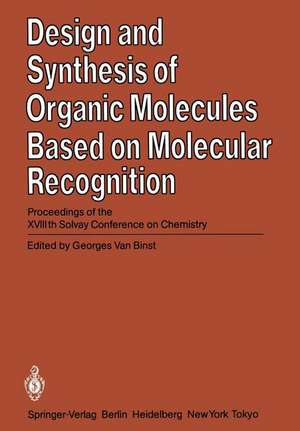Design and Synthesis of Organic Molecules Based on Molecular Recognition: Proceedings of the XVIIIth Solvay Conference on Chemistry Brussels, November 28 - December 01, 1983
E. Katchalski-Katzir Editat de Georges van Binst V. Prelogen Limba Engleză Paperback – 18 noi 2011
Preț: 644.63 lei
Preț vechi: 758.38 lei
-15% Nou
Puncte Express: 967
Preț estimativ în valută:
123.37€ • 127.82$ • 102.96£
123.37€ • 127.82$ • 102.96£
Carte tipărită la comandă
Livrare economică 21 martie-04 aprilie
Preluare comenzi: 021 569.72.76
Specificații
ISBN-13: 9783642709289
ISBN-10: 3642709281
Pagini: 336
Ilustrații: XVI, 316 p.
Dimensiuni: 170 x 244 x 18 mm
Greutate: 0.54 kg
Ediția:Softcover reprint of the original 1st ed. 1986
Editura: Springer Berlin, Heidelberg
Colecția Springer
Locul publicării:Berlin, Heidelberg, Germany
ISBN-10: 3642709281
Pagini: 336
Ilustrații: XVI, 316 p.
Dimensiuni: 170 x 244 x 18 mm
Greutate: 0.54 kg
Ediția:Softcover reprint of the original 1st ed. 1986
Editura: Springer Berlin, Heidelberg
Colecția Springer
Locul publicării:Berlin, Heidelberg, Germany
Public țintă
ResearchDescriere
A topic for a Solvay Conference should be general enough to conform with the great tradition of previous conferences. On the other hand it should not be so broad that it can not be covered during the limited time of the conference. After discussion of several such topics, "Design and Synthesis of Organic Molecules Based on Molecular Recognition" was chosen. According to Albert Einstein we live in an era of perfect methods and confused aims. For example in organic chemistry the known synthetic methods allow us to prepare an astronomical number of compounds; the gap between the possible and the relevant becomes larger every day. After discovery and classification of the main types of reactions, the study of the selectivity of reactions becomes of paramount importance. One can learn quite a lot from Nature, which uses molecular recognition to achieve selec tivity in a degree so far unattainable by mere mortals. To analyze the structural features applied by Nature, to accomplish high molecular recog nition, and to simulate these features by synthesis have recently become therefore favorite occupations of chemists. The purpose of this conference was to bring together two groups, the analysts and the syntheticists, to discuss the present status of the knowledge. This monograph contains the chairman's introduction in which he has summarized the main points at issue and the contributions of the renowned scientists who participated. The organizers hope that it will stimulate further research in this fascinating field.
Cuprins
Design and Synthesis of Organic Molecules Based on Molecular Recognition.- Discussion.- Topic 1. Molecular Recognition in Biochemical Processes.- Reports.- Specific Reversible Interactions in Life Processes: Antenna Function of Membranes and Their Regioselective, Conformation Selective and Stereoselective Interactions with Regulatory Peptides.- Discussion.- Functional Significance of Flexibility in Proteins.- Discussion.- Communications.- Antibodies of Predetermined Specificity in Biology and Medicine.- Calcium Trigger Proteins.- Glucagon Conformation in Different Environments: Implications for Molecular Recognition.- Topic 2. Thermodynamics, Kinetics and Stereochemistry in Molecular Recognition.- Reports.- On the Economics of Binding Energies.- Discussion.- Dynamics of Ligand Binding to Proteins.- Discussion.- Binding Energy and the Stimulation of Hormone Receptors.- Discussion.- Theoretical Studies of Molecular Recognition and Catalysis by Enzymes.- Discussion.- Communications.- Why Water?.- Discussion.- Experimental Studies of Protein-Dynamics Through Ligand Binding.- Topic 3. Synthetic Models of “Hosts”.- Reports.- Designed Host-Guest Relationships.- Discussion.- Molecular Recognition: Design of Abiotic Receptor Molecules.- Discussion.- Biomimetic Control of Chemical Selectivity.- Biopolymers in Reverse Micelles as Guest-Host Molecular Systems.- Discussion.- Communications.- Intimate Ion Pair Intermediates in the Solvolysis of Thio Addition Products of NAD (P)+ Analogs and Their Relevance to the Chemistry of 3-Phosphoglyceraldehyde Dehydrogenase.- Stereoselective Guest-Host Relationships.- Discussion.- On the Dynamics of Embedding in Imprinted Polymers.- Discussion.- Photo Reversible Affinity Labeling.- Discussion.- Topic 4. Design of New “Guests”.- Reports.- Molecular Discrimination in Crystal Growth in the Presence of “Tailor-Made” Inhibitors.- Discussion.- Binding and Information Transfer in Conformationally Restricted Peptides.- Communications.- Chiral Recognition in Partitioning Systems.- Discussion.- Designing Activity and Receptor Selectivity in Cyclic Peptide Hormone Analogs.- Concluding Remarks.- Concluding Remarks by a Physicist.- Some Aspects on Chemical versus Biochemical Recognition and Catalysis.- List of Authors.










